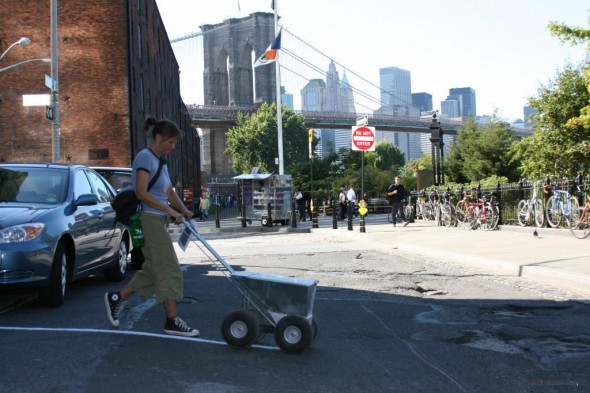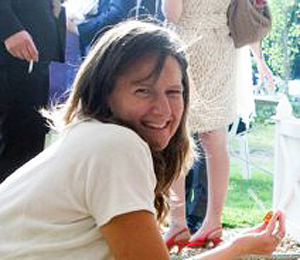“I never wanted to be right,” laments Eve Mosher. In 2007, she walked almost 70 miles of Brooklyn and Lower Manhattan, painting a chalk line showing the likely location of frequent flooding if sea levels continued to rise around the city. As she walked, she tried to engage the people who lived, worked, and played in those communities to focus on the danger climate change posed to coastal areas, inviting them to become part of a conversation about how to respond. Her “HighWaterLine” project proved to be a remarkably prescient forecaster of the city’s fate.

Eve Mosher, HighWaterLine (2007), Chalk, beacons, photography documenting performance. Dimensions: approximately 70 miles. Courtesy of the artist.
Artist’s statement
I create interactive public projects, like “HighWaterLine,” that abstractly investigate the human condition in relationship to our world. In 2006, I began producing large-scale projects that occur in public space and engage the audience directly on urban issues. My work utilizes art and performance to increase knowledge and understanding around environmental and social issues. My goal with each project is to create a space for participants to have a shared experience from which they learn and continue to share beyond the scope of the initial project.
When I traced the HighWaterLine in 2007, I didn’t set out to be a prophet(ess). I was hoping I could bring the conversation about climate change and its potential impacts to light in order to avoid this.
Hurricane Sandy brought the HighWaterLine into stark reality. I saw images of water up to and past where I drew the line. The images are shocking. The storm itself was scary, but the inundation is what crippled the city: sewage treatment plants, power stations, schools, hospitals, nursing homes and neighborhoods, inundated. If we don’t solve this, what do any of the other problems matter? What is good education without a school? Healthcare when hospitals can’t operate? Housing rights when your house has been washed away?
Artist’s website: www.evemosher.com
See also: http://www.highwaterline.org

